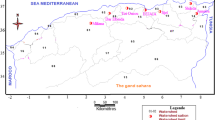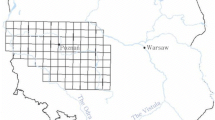Summary
During 1992 and 1995 in the Upper Rhine valley between Karlsruhe in the north and Basel in the south 36 energy balance stations were installed to analyze the spatial and temporal behavior of the components of the energy balance. A second aim of the project ‘Regio-Klima-Projekt’ (REKLIP) was to study the dependence of climatic variables on the energy balance. Three main influences on spatial variation in energy balance components were detected: orography, precipitation and land use. Concerning the dependence of the climatic variables on the energy balance it can be stated that the mean diurnal amplitude of temperature shows a good correlation with the mean diurnal sensible heat flux, while the diurnal amplitude of the specific humidity correlates with the mean diurnal latent heat flux. Both these results are in good agreement with theoretical considerations. Consequently, areas with enhanced sensible heat flux values show higher monthly mean temperature maxima and also a greater numbers of summer days, while areas with higher latent heat flux values indicate enhanced monthly mean humidity maxima.
Similar content being viewed by others
Author information
Authors and Affiliations
Additional information
Received February 26, 1998 Revised June 5, 1998
Rights and permissions
About this article
Cite this article
Kalthoff, N., Fiedler, F., Kohler, M. et al. Analysis of Energy Balance Components as a Function of Orography and Land Use and Comparison of Results with the Distribution of Variables Influencing Local Climate. Theor Appl Climatol 62, 65–84 (1999). https://doi.org/10.1007/s007040050075
Issue Date:
DOI: https://doi.org/10.1007/s007040050075




